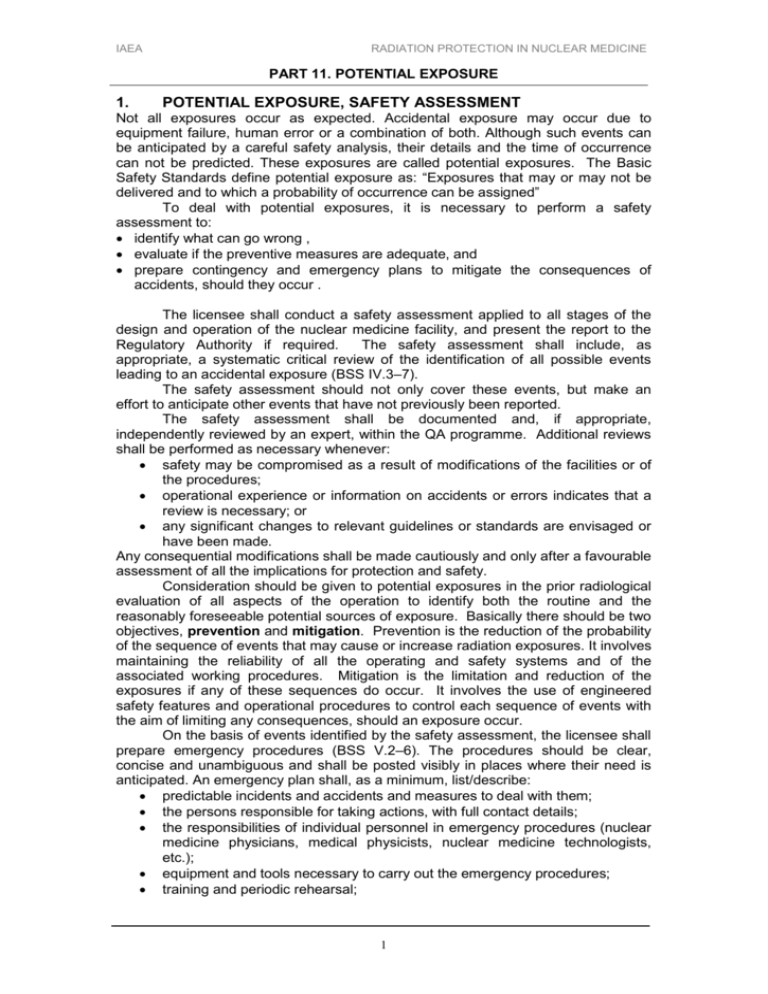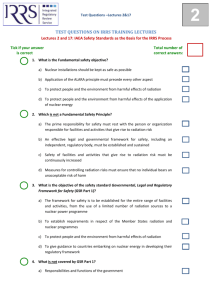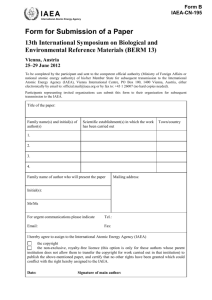11. Potential exposure - Radiation Protection of Patients
advertisement

IAEA RADIATION PROTECTION IN NUCLEAR MEDICINE PART 11. POTENTIAL EXPOSURE 1. POTENTIAL EXPOSURE, SAFETY ASSESSMENT Not all exposures occur as expected. Accidental exposure may occur due to equipment failure, human error or a combination of both. Although such events can be anticipated by a careful safety analysis, their details and the time of occurrence can not be predicted. These exposures are called potential exposures. The Basic Safety Standards define potential exposure as: “Exposures that may or may not be delivered and to which a probability of occurrence can be assigned” To deal with potential exposures, it is necessary to perform a safety assessment to: identify what can go wrong , evaluate if the preventive measures are adequate, and prepare contingency and emergency plans to mitigate the consequences of accidents, should they occur . The licensee shall conduct a safety assessment applied to all stages of the design and operation of the nuclear medicine facility, and present the report to the Regulatory Authority if required. The safety assessment shall include, as appropriate, a systematic critical review of the identification of all possible events leading to an accidental exposure (BSS IV.3–7). The safety assessment should not only cover these events, but make an effort to anticipate other events that have not previously been reported. The safety assessment shall be documented and, if appropriate, independently reviewed by an expert, within the QA programme. Additional reviews shall be performed as necessary whenever: safety may be compromised as a result of modifications of the facilities or of the procedures; operational experience or information on accidents or errors indicates that a review is necessary; or any significant changes to relevant guidelines or standards are envisaged or have been made. Any consequential modifications shall be made cautiously and only after a favourable assessment of all the implications for protection and safety. Consideration should be given to potential exposures in the prior radiological evaluation of all aspects of the operation to identify both the routine and the reasonably foreseeable potential sources of exposure. Basically there should be two objectives, prevention and mitigation. Prevention is the reduction of the probability of the sequence of events that may cause or increase radiation exposures. It involves maintaining the reliability of all the operating and safety systems and of the associated working procedures. Mitigation is the limitation and reduction of the exposures if any of these sequences do occur. It involves the use of engineered safety features and operational procedures to control each sequence of events with the aim of limiting any consequences, should an exposure occur. On the basis of events identified by the safety assessment, the licensee shall prepare emergency procedures (BSS V.2–6). The procedures should be clear, concise and unambiguous and shall be posted visibly in places where their need is anticipated. An emergency plan shall, as a minimum, list/describe: predictable incidents and accidents and measures to deal with them; the persons responsible for taking actions, with full contact details; the responsibilities of individual personnel in emergency procedures (nuclear medicine physicians, medical physicists, nuclear medicine technologists, etc.); equipment and tools necessary to carry out the emergency procedures; training and periodic rehearsal; 1 IAEA RADIATION PROTECTION IN NUCLEAR MEDICINE PART 11. POTENTIAL EXPOSURE recording and reporting system; immediate measures to avoid unnecessary radiation doses to patients, staff and public; measures to prevent access of persons to the affected area; and measures to prevent spread of contamination. In nuclear medicine the primary hazard from most sealed and unsealed radionuclide sources is that of external radiation by gamma rays. A secondary hazard could arise from internal radiation following accidental ingestion of the activity. If a serious spillage of radioactive material were to occur then both the shielding and the containment of the source could be lost. If a spillage of radioactive material were to occur then both the shielding and the containment of the source could be lost. The working practices described in the Local Rules should be followed at all times in order to prevent a spillage occurring and to minimize the consequences if one should occur. An accident involving damage to a 99Mo/99mTc radionuclide generator that resulted in the release of 99Mo would be one of the most serious foreseeable accidents that could occur in most nuclear medicine departments. If leakage of 99Mo from a generator is suspected the immediate area should be evacuated immediately and the radiation protection officer must be informed. Accidents and incidents involving patients are described below. In the event of a fire the normal hospital procedures should be observed. The safe evacuation of all patients, visitors and staff is the most important consideration. When the fire department arrives they should be informed of the presence of radioactive sources in the building. No one should be permitted to re-enter the building until it has been checked for contamination and re-entry approved by the radiation protection officer. In the event of an incident or accident, a comprehensive description of the incident should be prepared including the following information: a description of the incident by all persons involved, methods used to estimate the radiation dose received by those involved in the incident and implications of those methods for possible subsequent litigation, methods used to analyze the incident and to derive risk estimates from the data, the subsequent medical consequences for those exposed, the particulars of any subsequent legal proceedings that may ensue, conclusions drawn from the evaluation of the incident and recommendations on how to prevent a recurrence of such an accident. 2. ACCIDENT PREVENTION, LESSONS LEARNED The licensee shall incorporate within the RPP (BSS IV.10–12): defence in depth measures to cope with identified events, and an evaluation of the reliability of the safety systems (including administrative and operational procedures, and equipment and facility design); operational experience and lessons learned from accidents and errors. This information should be incorporated into the training, maintenance and QA programmes; The licensee shall promptly inform the Regulatory Authority of all reportable events, and make suitable arrangements to limit the consequences of any accident or incident that does occur. It must be emphasized that the best way to avoid radiation accidents is to have a structured radiation protection framework, together with associated quality assurance and quality control programmes. A safety culture should also have been implemented in the organization. A safety culture should include collection of 2 IAEA RADIATION PROTECTION IN NUCLEAR MEDICINE PART 11. POTENTIAL EXPOSURE information on unusual events, which led or might have led to incidents and accidents. This information provides material that can be used to prevent future accidents. Examples of accidents and incidents that have led to unintended medical exposure include treatment or examination of the wrong patient with the wrong activity and the wrong radiopharmaceutical as well as treatment or examination of pregnant or lactating female patients. Identified causes of these kinds of accidents and incidents include: Communication problems Busy environment, distraction Unknown local rules No training in emergency situations Not clearly defined responsibilities No efficient quality assurance In order to avoid future accidents it is important to learn from previous ones. The initiating event and the contributing factors can always be identified. This information provides material that should be used to prevent future accidents. This is achieved by having an efficient reporting system and a programme for continuous education and training. 3. REFERENCES 1. INTERNATIONAL ATOMIC ENERGY AGENCY. International Basic Safety Standards for Protection Against Ionizing Radiation and for the Safety of Radiation Sources. Safety Series No.115, IAEA, Vienna (1996). 2. INTERNATIONAL ATOMIC ENERGY AGENCY. Model Regulations on Radiation Safety in Nuclear Medicine. (in preparation). 3. INTERNATIONAL ATOMIC ENERGY AGENCY. Regulations for the Safe Transport of Radioactive Material. Safety Series No. ST-1, IAEA, Vienna (1996). 4. INTERNATIONAL ATOMIC ENERGY AGENCY. Safety Assessment Plans for Authorizations and Inspection of Radiation Sources. IAEA-TECDOC-1113, IAEA, Vienna (1999). 5. INTERNATIONAL ATOMIC ENERGY AGENCY, Generic Procedures for Assessment and Response During a Radiological Emergency. IAEATECDOC-1162, IAEA, Vienna (2000). 6. INTERNATIONAL ATOMIC ENERGY AGENCY. Safety Report on Methodology for Investigation of Radiation Accidents IAEA, Vienna (in press). 7. INTERNATIONAL ATOMIC ENERGY AGENCY. Lessons learned from accidents and errors in radiotherapy. IAEA, Vienna, 1997. 8. PAN AMERICAN HEALTH ORGANIZATION. Organization, development, quality control, and radiation protection in radiology services. PAHO Washington D.C., (1997). 9. NATIONAL COUNCIL ON RADIATION PROTECTION AND MEASUREMENTS Developing radiation emergency plans for academic, 3 IAEA RADIATION PROTECTION IN NUCLEAR MEDICINE PART 11. POTENTIAL EXPOSURE medical or industrial facilities. NCRP, Bethesda, 1991 (NCRP Report No. 111). 10. SERIS D. Human Factors and the Medical Use of Nuclear Byproduct Material. Proceedings of the Human Factors Society 33rd Annual Meeting, 1989 4








